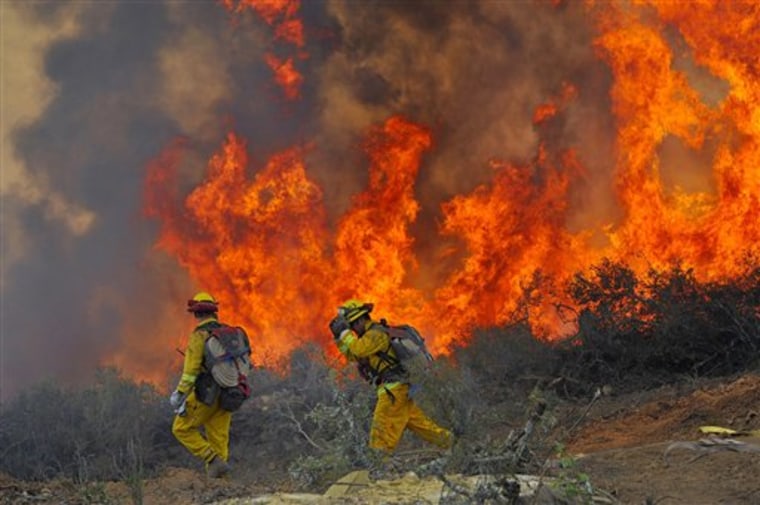When a firefighting helicopter went down in Northern California last week, killing nine and injuring four, the mountain crash site was so remote that it could only be reached by air or a full day's hike.
According to the U.S. Forest Service, fighting the stubborn wildfire in an area nowhere near homes or businesses was necessary because massive plumes of smoke were threatening the health of residents across the region.
But in a summer when a staggering number of wildfires are costing millions to fight, not everyone agrees that sending firefighters to backcountry blazes that pose no obvious threat to lives or property is the right approach.
"Sending them to put out a fire in the wilderness is both overkill and unnecessary," said Timothy Ingalsbee, a veteran firefighter and executive director of Firefighters United for Safety, Ethics and Ecology. "Firefighters are being ordered to take significant risks of their lives, health and safety that are incommensurate with ... the benefits of suppression."
Before the crash, most of the men who died had spent the day cutting fire lines in the Trinity Alps Wilderness, a protected area where under normal conditions federal law forbids all forms of mechanical transportation.
The blaze they were battling was part of a larger series of fires sparked across the Shasta-Trinity National Forest in late June.
By late July, fire had crept close enough to the nearby community of Junction City to force residents to evacuate. By Aug. 5, the day of the crash, all evacuation orders had been lifted for nearly a week.
Still, authorities believed that smoke pouring from blazes that had consumed 135 square miles posed a serious enough health hazard to keep firefighters on the front lines.
Furthermore, a decision had been made early on to bring the battle against the fires to the wilderness, based on experience that blazes in that part of the state grew large if not beaten down, said Kent Romney, a Shasta-Trinity National Forest spokesman.
"Those that are in wilderness areas tend to move out of wilderness areas," Romney said.
Media hysteria?
Some critics of federal wildfire-fighting policies aren't convinced.
Environmentalists have long argued that overzealous firefighting efforts fueled by media-driven hysteria are thwarting natural processes that have evolved over millennia to create a symbiotic relationship between forest ecosystems and wildfire.
Refusing to allow nature to run its course when homes and lives aren't threatened, they argue, creates an unnatural buildup of forest fuels that lead to more severe fires in the future.
A better strategy would depend on controlled burns set in the offseason to create buffer zones around communities that might otherwise be threatened, said Rich Fairbanks, a California wildfire expert with the nonprofit Wilderness Society.
"We ought to be treating these forests in the winter and the spring, not in August," Fairbanks said. "Why are you letting random events dictate how you manage these forests?"
Still, in the case of the wildfires plaguing far Northern California this summer, even Fairbanks believes the unusually harsh conditions compared with other years gave fire officials no choice but to fight them on every front.
From his home in southern Oregon, he said, he could see heavy smoke from the blazes drifting north day after day. And on the day after the crash, Gov. Arnold Schwarzenegger issued a state of emergency for neighboring Humboldt County because of "unprecedented smoke conditions."
Some agencies pulling crews off
The assessment that the scope of this year's fires made an aggressive posture the only choice was shared by the head of the Forest Service's Pacific Southwest Region, which includes California. In early July, chief forester Randy Moore issued a decision not to allow any wildfires in national forests to burn unchecked and to prohibit prescribed burns until the wildfire threat diminished.
Nevertheless, other agencies showed signs of employing a different strategy.
On Thursday, officials pulled crews off of a remote fire burning in Kings Canyon National Park after seven firefighters suffered minor injuries while working in steep terrain. Park spokeswoman Deb Schweizer said the fire, smaller than 1 square mile, posed no threat and has not created enough smoke to hurt air quality in the region.
"It's certainly not worth people getting hurt over," Schweizer said. Fire officials plan to continue flying over the blaze to map its spread.
